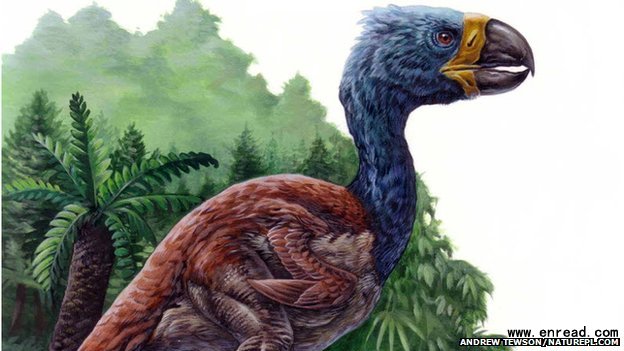|
  
- UID
- 86155
- 帖子
- 60350
- 积分
- 64892
- 学分
- 591606 个
- 金币
- 810 个
- 性别
- 男
- 在线时间
- 2779 小时

|
|
Footprints believed to have been made by the giant bird Diatryma indicate that it was a "gentle herbivore" and not a fierce carnivore, scientists say.
科学家称,巨型不飞鸟留下的脚印显示这种鸟是“温和的食草动物”,并非凶残的食肉动物。

The giant flightless Diatryma: unequipped to be a carnivore?
A team of researchers from Washington, US, examined tracks uncovered in a landslide in 2009.
Previous investigations have suggested the giant bird was a carnivorous predator or scavenger(食腐动物).
But the absence of raptor-like claws in the footprints supports the theory that Diatryma was not a meat-eater.
Measuring 7ft (2.13m) tall and with a huge head and beak, the giant flightless bird Diatryma (believed by some experts to belong to the genus Gastornis) is commonly portrayed as a fierce predator in both scientific works and popular media.
The animal is frequently thought as "the bird that replaced dinosaurs as the top predator", said geologist and team member George Mustoe, from Western Washington University in Bellingham, US.
"Let's be honest: scary, fierce meat-eaters attract a lot more attention than gentle herbivores."
The study, published in the journal Paleontology, analysed a set of footprints made 55.8 to 48.6 million years ago in the Lower Eocene. Preserved in sandstone, the prints formed part of the Chuckanut Formation in northwest Washington, US.
The team concluded that the multiple, well-preserved tracks were most likely to have been made by Diatryma.
That would make them the only known footprints left behind by this giant bird, and they provide new evidence about what it ate.
"[The tracks] clearly show that the animals did not have long talons, but rather short toenails(脚趾甲)," said David Tucker, from Western Washington University, who also worked on the study.
"This argues against an animal that catches prey and uses claws to hold it down. Carnivorous birds all have sharp, long talons."
更多英语新闻
|
|